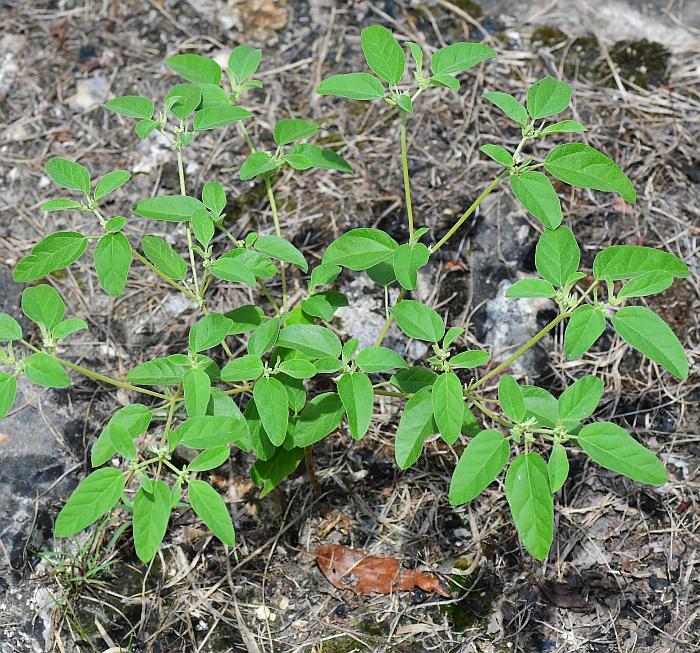Croton monanthogynus Michx.
One-Seeded Croton

Native
CC = 2
CW = 5
MOC = 76
© SRTurner
Croton monanthogynus Michx.One-Seeded Croton | |
 |
Native CC = 2 CW = 5 MOC = 76 |
© SRTurner |
|
Family - Euphorbiaceae Habit - Taprooted, monoecious, annual forb. Sap clear. Stems - Erect, to 40 cm, usually with 1 or few whorls of branches at or below the midpoint and repeatedly dichotomously branched above these, often forming a small tree-like plant, stellate-pubescent, slightly woody at the base.
Leaves - Alternate, simple, petiolate. Petioles to 2 cm long, stellate-pubescent. Blades 1-4 cm long, ovate to oblong-ovate or oblong-elliptic, rounded, angled or occasionally truncate at the base, mostly rounded at the tip (sometimes bluntly pointed or with an abrupt, minute, sharp point), the margins entire, the undersurface paler than the upper surface, the surfaces moderately to densely stellate-pubescent.
Inflorescences - Mostly short, dense, spikelike racemes or clusters, these terminal, axillary, and between upper stem branches, with pistillate flowers toward the base and staminate flowers toward the tip, the axis densely stellate-pubescent. Pedicels of staminate flowers to 1.5 mm long. Pedicels of pistillate flowers 1 mm long. All pedicels densely stellate-pubescent.
Flowers - Staminate flowers with the calyx deeply 4-lobed, 1.5-2.5 mm long; the petals 4-5, 1.5-2.5 mm long, white; the stamens 3-8. Filaments white, 1.4 mm long, glabrous. Anthers white, 0.6 mm broad. Pistillate flowers with the calyx 1.5-2.0 mm long at flowering, becoming slightly enlarged to 2-3 mm long at fruiting, 5-lobed; the petals absent; the ovary superior, globose-ovoid, densely stellate, green, 2-locular, the 2 styles each deeply 2-lobed.
Fruits - Capsules 3.5-4.0 mm in length, 2.5-3.5 mm in diameter, ovate in outline, not flattened, 1-seeded, dehiscent. Seeds 2.8-3.2 mm long, broadly elliptic to nearly circular in outline, slightly flattened, the caruncle present as a small knob.
Flowering - May - September. Habitat - Glades, upland prairies, tops of bluffs, savannas, upland forest openings, pastures, fields, railroads, roadsides, dry, open, disturbed areas. Origin - Native to the U.S. Lookalikes - C. capitatus, also C. lindheimerianus, which is rare in Missouri. Other info. - This inconspicuous little species is common throughout most of Missouri except for the north-central portion of the state. Elsewhere its range extends mainly throughout the lower U.S. Midwest and into Mexico. The plant is small but resembles a small tree because of its widely spreading branches. This species and another, C. capitatus, appear similar at first but are easily distinguished by close examination of the pistillate flowers and fruits. C. monanthogynus is the only Missouri croton which has two split styles for a total of 4 stigmatic branches. Although the ovaries are 2-locular, one of the ovules usually aborts, producing a single-seeded fruit. Photographs taken at Logan Creek, Reynolds County, MO., 7-6-03 (DETenaglia); also near Dutzow, Warren County, MO, 7-23-2016, at Danville Conservation Area, Montgomery County, MO, 8-23-2016, along Fox Creek, St. Louis County, MO, 9-2-2020, and at Shaw Nature Reserve, Franklin County, MO, 7-31-2022 (SRTurner). |